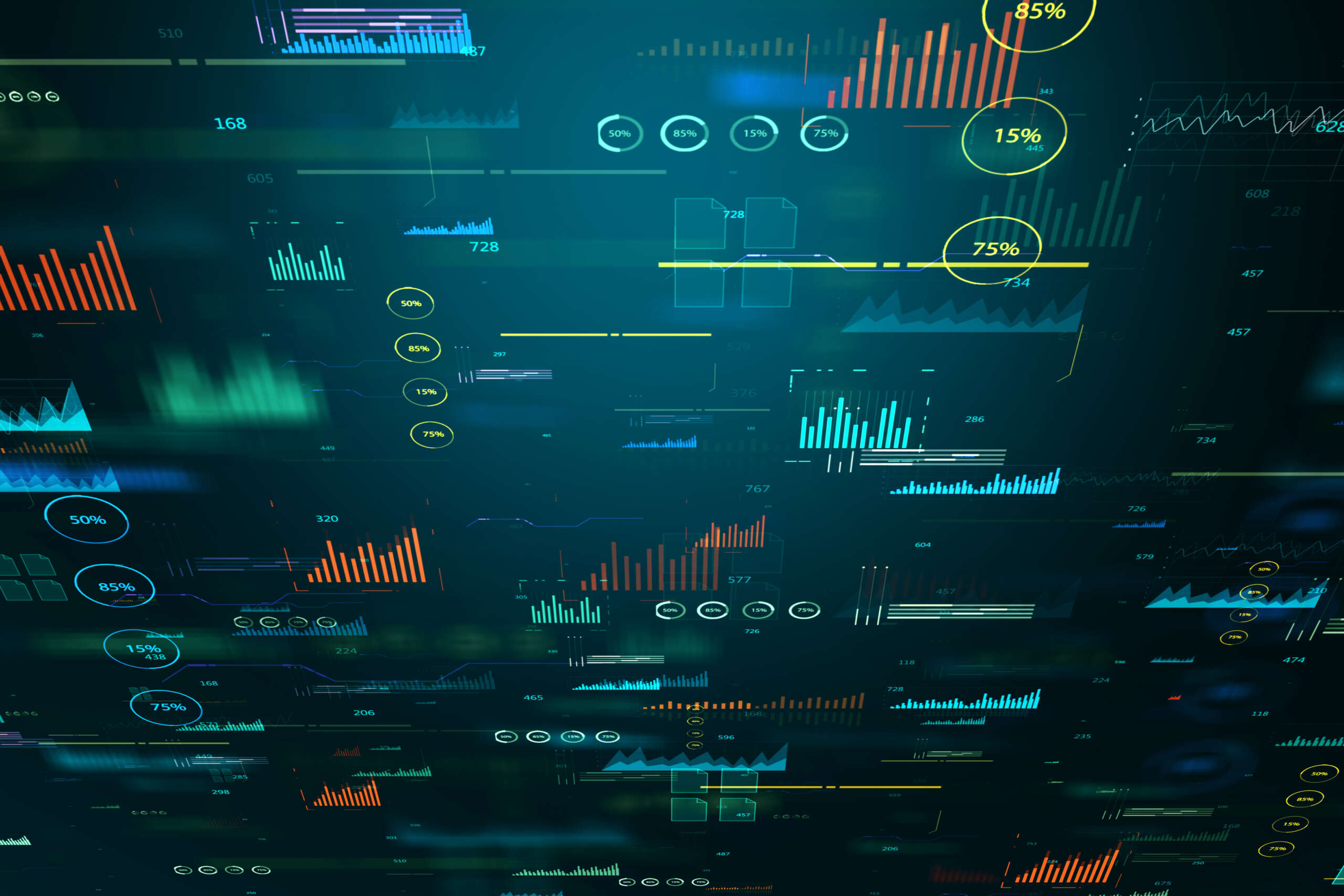Can we shape the future by predicting it today? This question is key to AI Predictive Analytics. It’s a new way to see what will happen next with great accuracy. It uses lots of data and smart algorithms to look into the future.
AI-driven forecasting is changing how businesses grow and make decisions. It doesn’t matter what kind of business, from finance to healthcare. Machine learning (ML) algorithms learn from past data to predict the future.
Banks use ML to spot credit risks and catch fraud. Retailers use it to guess what products will sell well and what customers will buy. Gartner says finance is leading in using ML for new ideas, with more uses coming soon. So, knowing about predictive analytics with AI is key for businesses to stay ahead.
But, using this tech has its challenges. Issues like having enough good data, making sense of complex models, and ethical and privacy worries exist. Overcoming these hurdles is important to make the most of AI predictive analysis. It ensures businesses stay competitive and innovate responsibly.
Understanding Predictive Analytics with AI in the Modern Business Landscape
In today’s economy, AI for business predictions and predictive modeling with AI are changing how businesses work. For example, an e-commerce company improved by automating data collection and analysis. This made operations smoother and used AI in trend analysis to make better decisions.

AI helps companies turn big data into useful insights quickly and accurately. This lets businesses understand market trends and customer behavior better. Retail stores, for instance, use predictive analytics to manage stock and tailor marketing, which increases customer loyalty.
In healthcare, AI has made a big difference. Hospitals saw a 25% drop in readmissions and used 15% less resources. This shows how predictive modeling with AI can improve many areas of a business.
Want to use predictive analytics in your business? Check out tips on implementing AI strategies. Predictive analytics are changing industries like manufacturing and finance, making them more productive and competitive.
AI in trend analysis is key for businesses to stay ahead. It helps in logistics, agriculture, and more, making AI essential for the future. Companies are looking for new ways to use their data with AI.
Predictive analytics with AI is crucial for modern business strategies. It helps businesses see the future and grow proactively for success.
How AI Predictive Analytics Is Transforming Decision-Making
The use of predictive tools with AI is changing how companies make decisions. It lets them use real-time data to plan ahead, something they couldn’t do before. This shift from reacting to events to acting before they happen is key in today’s fast market.

AI can look at huge amounts of data to find patterns and trends that are hard for humans to see. This helps companies predict what will happen next and plan their strategies. Adding behavioral insights to these predictions makes the forecasts even more accurate.
In manufacturing, AI helps use resources better and makes operations smoother. In healthcare, it improves how doctors diagnose patients. In retail, it helps manage stock and make shopping better for customers. In finance, it changes how companies predict market trends and manage risks.
AI predictive analytics forecast trends, identify risks, and recommend proactive strategies, providing a competitive edge by anticipating market shifts.
The predictive AI market is growing fast, going from USD 14.9 billion to USD 108 billion in a year. This shows how quickly AI is changing industries. It helps businesses grow and encourages a culture of always getting better and planning.
But, there are challenges like keeping data quality high and making AI processes clear. As companies try to stay ahead, AI will keep changing the business world. It will be shaped by deep business insights through AI.
Incorporating AI Predictive Analytics into Business Strategy
The rise of predictive analytics with AI in business strategies marks a big change. It moves towards making decisions based on data and improves how things work. These technologies help businesses understand huge amounts of data and predict future trends and behaviors very accurately.

For instance, big names like Amazon use AI-driven forecasting to boost their sales. Their AI-powered recommendation engines help customers make buying decisions. McKinsey says about 35% of Amazon’s income comes from using predictive analytics smartly. This shows how big a role AI can play in business plans.
But, it’s not just for big companies. Small businesses can use these tools too. They can use Google Analytics for deep data analysis or AI chatbots to improve customer service. These are smart ways that don’t cost a lot upfront.
A study by PwC predicts that AI will add $15.7 trillion to the global GDP by 2030. This shows the big benefits of using AI in business strategies. Companies with advanced analytics are also more likely to beat their competitors, as found by Bain & Company.
As the market keeps changing, companies need to stay flexible. About 59% of businesses, as Deloitte found, have updated their predictive models to fit new market trends and what customers want. AI helps in dealing with these changes and understanding future challenges and chances.
So, adding predictive analytics to a business plan is more than just getting new tech. It’s about changing how you look at the market and connect with customers. In this digital age, AI-driven forecasting will be key in making strategies that are ahead of the game.
AI Predictive Analytics: Techniques and Methodologies
The world of predictive analytics with AI is complex and full of different techniques. Regression analysis is key for predicting continuous data and helping businesses forecast sales and customer actions. It’s a powerful tool for precise predictions.
Machine learning boosts traditional methods with AI predictive models that get better over time. Decision trees help with sorting and predicting data, while neural networks are great for complex patterns in big data.
Time series analysis is vital for dealing with data that comes in order, like economic trends. Text analytics uses machine learning to sort and find trends in lots of text data.
In healthcare, predictive models use logistic regression to guess patient outcomes, improve treatment plans and manage resources. The finance sector uses these tools to catch fraud early with advanced algorithms.
In retail, predictive analytics techniques like clustering help sort customers into groups. This lets stores plan better for their customers. In manufacturing, predictive maintenance checks equipment to predict when it might break, keeping things running smoothly and avoiding big repair costs.
Using AI predictive models makes things more efficient and gives industries deep insights into what’s happening now and what might happen next. This helps businesses plan and make smart moves.
The Benefits and Challenges of Employing AI for Predictive Analysis
The use of AI-driven predictive tools is changing how companies handle data and make choices. These tools use machine learning and other advanced methods to help businesses predict the future. This helps them make better plans in areas like finance, healthcare, and retail.
One big plus of AI predictive analytics is how fast and accurately it can go through huge amounts of data. This is key in finance, healthcare, and retail, where knowing what customers will do next can help. It can make a big difference in profits and how well services work.
But, adding AI predictive analytics isn’t easy. First, you need lots of good-quality data to train the AI. Bad data can lead to wrong predictions, which can mess up business decisions. Also, AI models can be hard for non-experts to understand and use, so you might need to train people or hire experts.
There are also big worries about ethics and privacy as companies use more data. They have to balance making things more personal for customers with keeping their data safe. This means using AI in a way that respects people’s rights and follows the law.
A recent study shows the AI market could grow by 37.3%, which means big chances for the future. But, we also need to tackle the challenges. AI can make decisions better and make things run smoother, but we have to figure out how to use it right.
In the end, the benefits of AI predictive analytics are big, like making things more efficient and predicting better. But, companies need to think carefully before using it. To get the most out of AI-driven predictive tools, you need strong tech and a good set of rules. This way, you can use AI without losing trust from customers or hurting your own values.
Case Studies: AI Predictive Analytics in Action
AI predictive analytics show how they change business today. They are used in healthcare, finance, and retail. These tools help make big decisions better.
In healthcare, AI changes how we treat and watch over patients. It looks at patient history and research to guess disease outcomes. This makes care better and cuts costs. For instance, it helps predict health issues early, leading to better treatments.
“By using AI predictive models, healthcare providers can offer personalized medicine that predicts and prevents diseases before they happen.”
In finance, AI helps spot market trends and risks. It also finds fraud early. This means financial experts can make smart choices to keep money safe and growing.
For retailers, AI helps make marketing personal. It looks at what customers like and do. This makes customers happier and helps stores make more money. Retailers use AI to manage stock, guess what customers will buy, and plan better.
These examples show how AI predictive analytics change many areas. As AI gets better and more common, its uses will grow. This could change business and society even more.
Getting Started with AI Predictive Analytics for Your Business
Starting with AI predictive analytics is a smart move for your business. It helps make better decisions and stay ahead of the competition. Many industries, like healthcare and finance, see how AI changes the game by analyzing lots of data.
To start, define your goals and where AI can help the most, like in sales or understanding customers. This focus guides your AI journey.
AI predictive analytics is a big leap from old methods. It can go through millions of data points in minutes, offering quick solutions. Companies begin by defining their issues, cleaning the data, and building predictive models with tools like regression analysis.
After making models, it’s crucial to check their accuracy before using them. This ensures the insights are reliable.
AI predictive analytics keeps learning and improving. It needs regular updates to keep up with new data and market changes. By choosing the right AI tools, businesses in various sectors can predict trends and improve areas like fraud detection.
Starting with AI predictive analytics is more than just adopting new tech. It’s about a continuous process that boosts efficiency, sharpens focus, and transforms your business.



